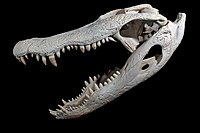Crocodilia
| Crocodilia | |
|---|---|

| |
| Clockwise from top-left: saltwater crocodile (Crocodylus porosus), American alligator (Alligator mississippiensis), and gharial (Gavialis gangeticus) | |
| Scientific classification | |
| Domain: | Eukaryota |
| Kingdom: | Animalia |
| Phylum: | Chordata |
| Class: | Reptilia |
| Clade: | Archosauria |
| Clade: | Pseudosuchia |
| Clade: | Crocodylomorpha |
| Clade: | Crocodyliformes |
| Clade: | Eusuchia |
| Order: | Crocodilia Owen, 1842 |
| Subgroups | |
| |

| |
| Crocodylia distribution on land (green) and at sea (blue) | |
Crocodilia (or Crocodylia, both
Large, solidly built, lizard-like reptiles, crocodilians have long flattened snouts, laterally compressed tails, and eyes, ears, and nostrils at the top of the head. They swim well and can move on land in a "high walk" and a "low walk", while smaller species are even capable of galloping. Their skin is thick and covered in non-overlapping scales. They have conical, peg-like teeth and a powerful bite. They have a four-chambered
Crocodilians are found mainly in lowlands in the
Some species of crocodilians are known to have
Spelling and etymology
Crocodilia and Crocodylia have been used interchangeably for decades starting with Schmidt's redescription of the group from the formerly defunct term Loricata.[1] Schmidt used the older term Crocodilia, based on Owen's original name for the group.[2] Shortly after, Wermuth opted for Crocodylia as the proper name for this redescribed group,[3] basing it on the type genus Crocodylus (Laurenti, 1768).[4] Dundee—in a revision of many reptilian and amphibian names—argued strongly for Crocodylia to be the spelling for the group.[5] However, it was not until the advent of cladistics and phylogenetic nomenclature that a more solid justification (priority) for one spelling over the other was proposed.[6]
Prior to 1988, Crocodilia (also called Crocodylia) was a group that encompassed the modern-day animals, as well as their more distant relatives now in the larger groups called
Crocodilia[2] appears to be a Latinizing of the Greek κροκόδειλος (crocodeilos), which means both lizard and Nile crocodile.[7] Crocodylia, as coined by Wermuth,[3] in regards to the genus Crocodylus appears to be derived from the ancient Greek[8] κρόκη (kroke)—meaning shingle or pebble—and δρîλος or δρεîλος (dr(e)ilos) for "worm". The name may refer to the animal's habit of basking on the pebbled shores of the Nile.[9]
Taxonomy and classification
Evolution
The main distinguishing characteristic of diapsid tetrapods is the presence of two openings (temporal fenestrae) on either side of the skull behind the eye. Living diapsids include modern reptiles and birds.[10] The feature that distinguishes archosaurs from other diapsids is an extra pair of openings in the skull (antorbital fenestrae) in front of the eye sockets. Archosauria is the crown group containing the most recent common ancestor of crocodilians and birds and all its descendants. It comprises the Pseudosuchia, the "false crocodiles", and the Avemetatarsalia, which in turn comprises the dinosaurs (including birds) and pterosaurs.[11] Pseudosuchia is defined as living crocodilians and all archosaurs more closely related to crocodilians than to birds. The Pseudosuchia–bird split is assumed to have occurred close to the Permian–Triassic mass extinction event.[12] In modern crocodilians, the antorbital fenestrae are walled off externally and exist merely as sinuses.[13] They were present in most of their fossil ancestors as small openings.[14]
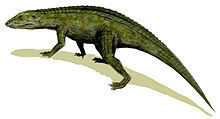
The ancestors of today's
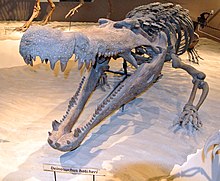
Protosuchians were small, mostly terrestrial animals with short snouts and long limbs. They had bony armor in the form of two rows of plates extending from head to tail, and this armor is retained by most modern crocodilians. Their vertebrae were convex on the two main articulating surfaces, and their bony palates were little developed. The mesosuchians saw a fusion of the
The three primary branches of Crocodilia had diverged by the end of the Mesozoic. The possible earliest-known members of the group may be Portugalosuchus from the Cenomanian (95 million years ago),[20] though the classification of this taxon has been disputed.[21][22] After are alligatoroids and gavialoids that lived in North America and Europe during the Campanian (around 83.6–72.1 million years ago). The first known crocodyloids appeared in the Maastrichtian (around 72.1–66.0 million years ago), that lineage must have been present during the Campanian, and the earliest alligatoroids and gavialoids include highly derived forms, which indicates that the time of the actual divergence between the three lineages must have been a pre-Campanian event.[6]
Scientists conclude that environmental factors played a major role in the evolution of crocodilians and their ancestors, with warmer climate being associated with high evolutionary rates and large body sizes.[23]
Relationships
Crocodylia is

However, recent molecular studies using DNA sequencing of living crocodilians have rejected this distinct group Brevirostres, with the long-snouted gavialids more closely related to crocodiles than to alligators, with the new grouping of gavialids and crocodiles named Longirostres.[26][27][28][29][30]
Below is a cladogram showing the relationships of the major
| Crocodilia |
| ||||||||||||||||||
Anatomy and physiology

Crocodilians range in size from the Paleosuchus and Osteolaemus species, which reach 1–1.5 m (3 ft 3 in – 4 ft 11 in), to the saltwater crocodile, which reaches 7 m (23 ft) and weighs up to 2,000 kg (4,400 lb), though some prehistoric species such as the late Cretaceous Deinosuchus were even larger at up to about 11 m (36 ft)[31] and 3,450 kg (7,610 lb).[28] They tend to be sexually dimorphic, with males much larger than females.[32] Though there is diversity in snout and tooth shape, all crocodilian species have essentially the same body morphology.[28] They have solidly built, lizard-like bodies with elongated, flattened snouts and laterally compressed tails.[32] Their limbs are reduced in size; the front feet have five digits with little or no webbing, and the hind feet have four webbed digits and a rudimentary fifth.[33]
The skeleton is somewhat typical of
Locomotion
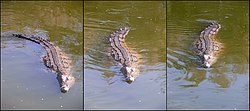
Crocodilians are excellent swimmers. During
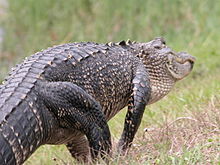
The high walk of crocodilians, with the belly and most of the tail being held off the ground, is unique among living reptiles. It somewhat resembles the walk of a mammal, with the same sequence of limb movements: left fore, right hind, right fore, left hind.[41] The low walk is similar to the high walk, but without the body being raised, and is quite different from the sprawling walk of salamanders and lizards. The animal can change from one walk to the other instantaneously, but the high walk is the usual means of locomotion on land. The animal may push its body up and use this form immediately, or may take one or two strides of low walk before raising the body higher. Unlike most other land vertebrates, when crocodilians increase their pace of travel they increase the speed at which the lower half of each limb (rather than the whole leg) swings forward; by this means, stride length increases while stride duration decreases.[43]
Though typically slow on land, crocodilians can produce brief bursts of speed, and some can run at 12 to 14 km/h (7.5 to 8.7 mph) for short distances.
Jaws and teeth
The snout shape of crocodilians varies between species. Crocodiles may have either broad or slender snouts, while alligators and caimans have mostly broad ones. Gharials have snouts that are extremely elongated. The muscles that close the jaws are much more massive and powerful than the ones that open them,[32] and a crocodilian's jaws can be held shut by a person fairly easily. Conversely, the jaws are extremely difficult to pry open.[47] The powerful closing muscles attach at the median portion of the lower jaw and the jaw hinge attaches to the atlanto-occipital joint, allowing the animal to open its mouth fairly wide. The tongue cannot move freely but is held in place by a folded membrane.[34]
Crocodilians have some of the strongest bite forces in the animal kingdom. In a study published in 2003, an American alligator's bite force was measured at up to 2,125 lbf (9.45 kN).
Crocodilian teeth vary from blunt and dull to sharp and needle-like.[28] Broad-snouted species have teeth that vary in size, while those of slender-snouted species are more uniform. The teeth of crocodiles and gharials tend to be more visible than those of alligators and caimans when the jaws are closed.[49] The easiest way to distinguish crocodiles from alligators is by looking at their jaw line. The teeth on the lower jaw of an alligator fit into sockets in the upper jaw, so only the upper teeth are visible when the mouth is closed. The teeth on the lower jaw of a crocodile fit into grooves on the outside of the top jaw making both the upper and lower teeth visible when the mouth is closed.[50]
Crocodilians are
Sense organs

The eyes, ears and nostrils of crocodilians are at the top of the head. This allows them to stalk their prey with most of their bodies underwater.
The ears are adapted for hearing both in air and underwater, and the
Skin and scales
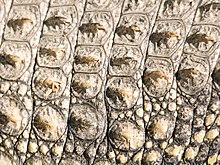
The skin of crocodilians is thick and
Many of the scutes are strengthened by bony plates known as osteoderms, which are the same size and shape as the superficial scales but grow beneath them. They are most numerous on the back and neck of the animal and may form a protective armour. They often have prominent, lumpy ridges and are covered in hard-wearing beta-keratin.[32] The head and jaws lack actual scales and are instead covered in tight keratinised skin that cracks due to stress.[66] The skin on the neck and flanks is loose, while that on the abdomen and underside of the tail is sheathed in large, flat square scutes arranged in neat rows.[32][67] The scutes contain blood vessels and may act to absorb or radiate heat during thermoregulation.[32] Research also suggests that alkaline ions released into the blood from the calcium and magnesium in these dermal bones act as a buffer during prolonged submersion when increasing levels of carbon dioxide would otherwise cause acidosis.[68]
Some scutes contain a single pore known as an integumentary sense organ. Crocodiles and gharials have these on large parts of their bodies, while alligators and caimans only have them on the head. Their exact function is not fully understood, but it has been suggested that they may be
In the genus Crocodylus the skin contains chromatophores, allowing them to change color from dark to light and vice versa.[71]
Circulation

The crocodilian has perhaps the most complex vertebrate circulatory system. It has a four-chambered heart and two ventricles, an unusual trait among extant reptiles,[72] and both a left and right aorta which are connected by a hole called the Foramen of Panizza. Like birds and mammals, crocodilians have heart valves that direct blood flow in a single direction through the heart chambers. They also have unique cog-teeth-like valves that, when interlocked, direct blood to the left aorta and away from the lungs, and then back around the body.[73] This system may allow the animals to remain submerged for a longer period,[74] but this explanation has been questioned.[75] Other possible reasons for the peculiar circulatory system include assistance with thermoregulatory needs, prevention of pulmonary oedema, or faster recovery from metabolic acidosis. Retaining carbon dioxide within the body permits an increase in the rate of gastric acid secretion and thus the efficiency of digestion, and other gastrointestinal organs such as the pancreas, spleen, small intestine, and liver also function more efficiently.[76]
When submerged, a crocodilian's heart rate slows down to one or two beats a minute, and blood flow to the muscles is reduced. When it rises and takes a breath, its heart rate speeds up in seconds, and the muscles receive newly oxygenated blood.
Respiration
Crocodilians were traditionally thought to breathe like mammals, with airflow moving in and out tidally, but studies published in 2010 and 2013 conclude that crocodilians breathe more
The lungs of crocodilians are attached to the liver and the pelvis by the diaphragmaticus muscle (
Swimming and diving crocodilians appear to rely on
Vocalizing is produced by vibrating
Digestion
Crocodilian teeth are adapted for seizing and holding prey, and food is swallowed unchewed. The digestive tract is relatively short, as meat is a fairly simple substance to digest. The stomach is divided into two parts: a muscular gizzard that grinds food, and a digestive chamber where enzymes work on it.[90] Indigestible items are regurgitated as pellets.[91] The stomach is more acidic than that of any other vertebrate and contains ridges for gastroliths, which play a role in the mechanical breakdown of food. Digestion takes place more quickly at higher temperatures.[39] When digesting a meal, CO2-rich blood towards the lungs is redirected to the stomach where glands make use of the CO2 to form bicarbonate and gastric acid secretions approximately 10 times the highest rates measured in mammals.[92][93] Alligators have a higher ability to digest carbohydrates relative to protein compared to crocodiles.[94] Crocodilians have a very low metabolic rate and consequently, low energy requirements. This allows them to survive for many months on a single large meal, digesting the food slowly. They can withstand extended fasting, living on stored fat between meals. Even recently hatched crocodiles are able to survive 58 days without food, losing 23% of their bodyweight during this time.[95] An adult crocodile needs between a tenth and a fifth of the amount of food necessary for a lion of the same weight, and can live for half a year without eating.[95]
Thermoregulation

Crocodilians are ectotherms, producing relatively little heat internally and relying on external sources to raise their body temperatures. The sun's heat is the main means of warming for any crocodilian, while immersion in water may either raise its temperature by conduction, or cool the animal in hot weather. The main method for regulating its temperature is behavioural. For example, an alligator in temperate regions may start the day by basking in the sun on land. A bulky animal, it warms up slowly, but at some time later in the day it moves into the water, still exposing its dorsal surface to the sun. At night it remains submerged, and its temperature slowly falls. The basking period is extended in winter and reduced in summer. For crocodiles in the tropics, avoiding overheating is generally the main problem. They may bask briefly in the morning but then move into the shade, remaining there for the rest of the day, or submerge themselves in water to keep cool. Gaping with the mouth can provide cooling by evaporation from the mouth lining.[96] By these means, the temperature range of crocodilians is usually maintained between 25 and 35 °C (77 and 95 °F), and mainly stays in the range 30 to 33 °C (86 to 91 °F).[97]
The ranges of the American and Chinese alligator extend into regions that sometimes experience periods of frost in winter. Being ectothermic, the internal body temperature of crocodilians falls as the temperature drops, and they become sluggish. They may become more active on warm days, but do not usually feed at all during the winter. In cold weather, they remain submerged with their tails in deeper, less cold water and their nostrils just projecting through the surface. If ice forms on the water, they maintain ice-free breathing holes, and there have been occasions when their snouts have become frozen into the ice. Temperature sensing probes implanted in wild American alligators have found that their core body temperatures can descend to around 5 °C (41 °F), but as long as they remain able to breathe they show no ill effects when the weather warms up.[96]
Osmoregulation
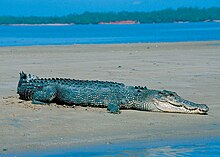
No living species of crocodilian can be considered truly marine; although the
The kidneys and excretory system are much the same as in other reptiles, but crocodilians do not have a
Distribution and habitat

Crocodilians are
Various types of aquatic habitats are used by different crocodilians. Some species are relatively more terrestrial and prefer swamps, ponds, and the edges of lakes, where they can bask in the sun and there is plenty of plant life supporting a diverse fauna. Others spend more time in the water and inhabit the lower stretches of rivers, mangrove swamps, and estuaries. These habitats also have a rich flora and provide plenty of food. The Asian gharials find the fish on which they feed in the pools and backwaters of swift rivers. South American
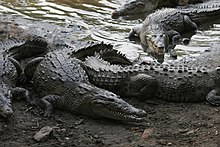
Dry land is also important as it provides opportunities for basking, nesting, and escaping from temperature extremes. Gaping allows evaporation of moisture from the mouth lining and has a cooling effect, and several species make use of shallow burrows on land to keep cool. Wallowing in mud can also help prevent them from overheating.[109] Four species of crocodilians climb trees to bask in areas lacking a shoreline.[110] The type of vegetation bordering the rivers and lakes inhabited by crocodilians is mostly humid tropical forest, with mangrove swamps in estuarine areas. These forests are of great importance to the crocodilians, creating suitable microhabitats where they can flourish. The roots of the trees absorb water when it rains, releasing it back slowly into the environment. When the forests are cleared to make way for agriculture, rivers tend to silt up, the water runs off rapidly, the water courses can dry up in the dry season and flooding can occur in the wet season. Destruction of forest habitat is probably a greater threat to crocodilians than hunting.[111]
Ecological roles

Being highly efficient predators, crocodilians tend to be top of the
In the Amazon basin, when caimans became scarce as a result of overhunting in the mid-20th century, the number of local fish, such as the important arapaima (Arapaima gigas), also decreased. These are nutrient-poor waters, and the urine and faeces of the caimans may have increased primary production by contributing plant nutrients. Thus the presence of the reptiles could have benefited the fish stock;[115] the number of crocodilians in a stretch of water appears to be correlated with the fish population.[116]
Behavior and life history
Cognition
Crocodilians are among the most cognitively complex nonavian reptiles, though their behavioral repertoire is less well understood than other vertebrates due to the difficulty of monitoring solitary and often nocturnal predators in aquatic habitats.
Embryological studies of developing amniotes have shown similar brain structures in the
Spacing
Adult crocodilians are typically
Feeding

Crocodilians are largely
In general, crocodilians are stalk-and-ambush predators,[28] though hunting strategies vary depending on the individual species and the prey being hunted.[39] Terrestrial prey is stalked from the water's edge and then grabbed and drowned.[39][123] Gharials and other fish-eating species sweep their jaws sideways to snap up prey, and these animals can leap out of the water to catch birds, bats, and leaping fish.[112] A small animal can be killed by whiplash as the predator shakes its head.[123] Caimans use their tails and bodies to herd fish into shallow water.[39] They may also dig for bottom-dwelling invertebrates,[33] and the smooth-fronted caiman will even hunt on land.[28] Most species will eat anything suitable that comes within reach and are also opportunistic scavengers.[33]

Crocodilians are unable to chew and need to swallow food whole, so prey that is too large to swallow is torn into pieces. They may be unable to deal with a large animal with a thick hide, and may wait until it becomes putrid and comes apart more easily.[112] To tear a chunk of tissue from a large carcass, a crocodilian spins its body continuously while holding on with its jaws, a maneuver known as the "death roll".[124] During cooperative feeding, some individuals may hold on to the prey, while others perform the roll. The animals do not fight, and each retires with a piece of flesh and awaits its next feeding turn.[125] After feeding together, individuals may go their separate ways.[119] Food is typically consumed by crocodilians with their heads above water. The food is held with the tips of the jaws, tossed towards the back of the mouth by an upward jerk of the head and then gulped down.[123] Nile crocodiles may store carcasses underwater for later consumption.[33]
Reproduction and parenting
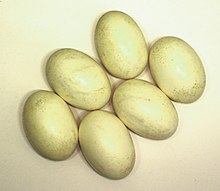
Crocodilians are generally


Depending on the species, female crocodilians may construct either holes or mounds as nests,[39] the latter made from vegetation, litter, sand, or soil.[102] Nests are typically found near dens or caves. Those made by different females are sometimes close to each other, particularly in hole-nesting species. The number of eggs laid in a single clutch ranges from ten to fifty. Crocodilian eggs are protected by hard shells made of calcium carbonate. The incubation period is two to three months.[39] The temperature at which the eggs incubate determines the sex of the hatchlings. Constant nest temperatures above 32 °C (90 °F) produce more males, while those below 31 °C (88 °F) produce more females. However, sex in crocodilians may be determined in a short interval, and nests are subject to changes in temperature. Most natural nests produce hatchlings of both sexes, though single-sex clutches do occur.[102]
The young may all hatch in a single night.[130] Crocodilians are unusual among reptiles in the amount of parental care provided after the young hatch.[129][39] The mother helps excavate hatchlings from the nest and carries them to water in her mouth. Newly hatched crocodilians gather together and stay close to their mother.[131] Both male and female adult crocodilians will respond to vocalizations by hatchlings.[129] For spectacled caimans in the Venezuelan llanos, individual mothers are known to leave their young in the same nurseries, or crèches, and one of the mothers guards them.[132] Hatchlings of many species tend to bask in a group during the day and disperse at nightfall to feed.[130] The time it takes young crocodilians to reach independence can vary. For American alligators, groups of young associate with adults for one to two years, while juvenile saltwater and Nile crocodiles become independent in a few months.[39]
Communication
Crocodilians can communicate with various sounds, including bellows, roars, growls, grunts, barks, coughs, hisses, toots, moos, whines, and chirps.[86] Young start communicating with each other before they are hatched. It has been shown that a light tapping noise near the nest will be repeated by the young, one after another. Such early communication may help them to hatch simultaneously. Once it has broken out of the egg, a juvenile produces yelps and grunts either spontaneously or as a result of external stimuli and even unrelated adults respond quickly to juvenile distress calls.[130]
Vocalisations are frequent as the juveniles disperse, and again as they congregate in the morning. Nearby adults, presumably the parents, also give signals warning of predators or alerting the youngsters to the presence of food. The range and quantity of vocalisations vary between species. Alligators are the noisiest, while some crocodile species are almost completely silent. Adult female
Another form of acoustic communication is the head slap. This typically starts with an animal in the water elevating its snout and remaining stationary. After some time, the jaws are opened sharply then clamped shut with a biting motion that makes a loud slapping sound, and this is immediately followed by a loud splash, after which the head may be submerged and copious bubbles produced. Some species then roar, while others slap the water with their tails. Episodes of head slapping spread through the group. The purpose varies, but it seems to be associated with maintaining social relationships, and is also used in courtship.[130] Dominant individuals may also display their body size while swimming at the water surface, and a subordinate will submit by holding its head at an acute angle with the jaws open before retreating underwater.[39]
Growth and mortality

Mortality is high for eggs and hatchlings, and nests face threats from floods, overheating, and predators.[39] Flooding is a major cause of failure of crocodilians to breed successfully: nests are submerged, developing embryos are deprived of oxygen, and juveniles get washed away.[111] Numerous predators, both mammalian and reptilian, may raid nests and eat crocodilian eggs.[135][136] Despite the maternal care they receive, hatchlings commonly fall to predation.[137] While the female is transporting some to the nursery area, others are picked off by predators that lurk near the nest. In addition to terrestrial predators, the hatchlings are also subject to aquatic attacks by fish. Birds take their toll, and in any clutch there may be malformed individuals that are unlikely to survive.[135] In northern Australia, the survival rate for saltwater crocodile hatchlings is only twenty-five percent, but with each succeeding year of life this improves, reaching sixty percent by year five.[137]
Mortality rates are fairly low among subadults and adults, though they are occasionally preyed on by large cats and snakes.
Growth in hatchlings and young crocodilians depends on the food supply, and sexual maturity is linked with length rather than age. Female saltwater crocodiles reach maturity at 2.2–2.5 m (7–8 ft), while males mature at 3 m (10 ft). Australian freshwater crocodiles take ten years to reach maturity at 1.4 m (4 ft 7 in). The spectacled caiman matures earlier, reaching its mature length of 1.2 m (4 ft) in four to seven years.[126] Crocodilians continue to grow throughout their lives. Males in particular continue to gain in weight as they get older, but this is mostly in the form of extra girth rather than length.[140] Crocodilians can live 35–75 years,[51] and their age can be determined by growth rings in their bones.[126][140] The oldest known crocodile, which is also the largest known individual, is an Australian crocodile that has lived in captivity since 1984 and is estimated to be 120 years old.[141]
Interactions with humans
Farming and ranching


Alligators and crocodiles were first farmed in the early 20th century, but the facilities involved were
Alligator and crocodile farming began because of demand for their hides, but now nearly all parts of the animal are put to use. The side and belly skin make the best leather, the meat is eaten, the gallbladders are valued in East Asia, and the heads are sometimes made into ornaments.[143] In traditional Chinese medicine, alligator meat is said to cure the common cold and prevent cancer, while various internal organs are believed to have medicinal properties.[144]
Attacks
Crocodilians are opportunistic predators that are at their most dangerous in water and at the edge of water. Several species are known to attack humans and may do so to defend their territories, nests, or young; by mistake, while attacking domestic animals such as dogs; or for food, as larger crocodilians can take prey as big as or bigger than humans. The species on which there is most data are the saltwater crocodile, the Nile crocodile, and the American alligator. Other species which have sometimes attacked humans are the black caiman, the Morelet's crocodile, the mugger crocodile, the American crocodile, the gharial, and the freshwater crocodile.[145]

The Nile crocodile has a reputation as the biggest killer of large animals, including humans, on the African continent. It is widely distributed, found in many habitats and cryptically coloured. From a waiting position with only its eyes and nostrils above the water, it can lunge at drinking animals, fishermen, bathers, or people collecting water or washing clothes. Once seized and dragged into the water, there is little chance for the victim to escape. Analysis of attacks show that most take place during the breeding season or when crocodiles are guarding nests or newly hatched young.[146] Although many attacks go unreported, there are estimated to be over 300 per year, 63% of which are fatal.[145] Wild saltwater crocodiles in Australia carried out 62 confirmed and unprovoked attacks causing injury or death between 1971 and 2004. These animals have also caused fatalities in Malaysia, New Guinea, and elsewhere. They are highly territorial and resent intrusion into their territories by other crocodiles, humans, or boats such as canoes. Attacks may come from animals of various sizes, but the larger males are generally responsible for fatalities. As their size increases, so does their need for larger mammalian prey; pigs, cattle, horses, and humans are all within the size range they seek. Most of the people attacked were either swimming or wading, but in two instances they were asleep in tents.[147]
American alligators are recorded as making 242 unprovoked attacks between 1948 and mid-2004, causing sixteen human fatalities. Ten of these were in the water and two were on land; the circumstances of the other four are not known. Most attacks were in the warmer months of the year, though in Florida, with its warmer climate, attacks can happen at any time of year.[145] Alligators are considered to be less aggressive than either the Nile or saltwater crocodile,[148] but the increase in density of the human population in the Everglades has brought people and alligators into proximity and increased the risk of alligator attacks.[145][148] Conversely in Mauritania, where the crocodiles' growth is severely stunted by the arid conditions, the local people swim with them without being attacked.[108]
As pets
Several species of crocodilian are traded as exotic pets. They are appealing when young, and pet-store owners can easily sell them, but crocodilians do not make good pets; they grow large and are both dangerous and expensive to keep. As they grow older, pet crocodilians are often abandoned by their owners, and feral populations of spectacled caimans exist in the United States and Cuba. Most countries have strict regulations for keeping these reptiles.[149]
In medicine
The blood of alligators and crocodiles contains peptides with antibiotic properties. According to National Geographic, these may contribute to future antibacterial drugs.[150] Cartilage from crocodiles raised in crocodile farms is also used in research to 3D-print new cartilage for humans by mixing human stem cells with liquified crocodile cartilage after proteins that may trigger the human immune system has been removed.[151]
Conservation
The main threat to crocodilians around the world is human activity, including hunting and habitat destruction. Early in the 1970s, more than 2 million wild crocodilian skins of a variety of species had been traded, driving down the majority of crocodilian populations, in some cases almost to extinction. Starting in 1973, CITES attempted to prevent trade in body parts of endangered animals, such as the skins of crocodiles. This proved to be problematic in the 1980s, as crocodiles were abundant and dangerous to humans in some parts of Africa, and it was legal to hunt them. At the Conference of the Parties in Botswana in 1983, it was argued on behalf of aggrieved local people that it was reasonable to sell the lawfully hunted skins. In the late 1970s, crocodiles began to be farmed in different countries, started from eggs taken from the wild. By the 1980s, farmed crocodile skins were produced in sufficient numbers to destroy the unlawful trade in wild crocodilians. By 2000, skins from twelve crocodilian species, whether harvested lawfully in the wild or farmed, were traded by thirty countries, and the unlawful trade in the products had almost vanished.[152]

The gharial has undergone a chronic long-term decline, combined with a rapid short-term decline, leading the
The American alligator has also suffered serious declines from hunting and habitat loss throughout its range, threatening it with extinction. In 1967 it was listed as an endangered species, but the United States Fish and Wildlife Service and state wildlife agencies in the Southern United States stepped in and worked towards its recovery. Protection allowed the species to recuperate, and in 1987 it was removed from the endangered species list.[159] Much research into alligator ranching has been undertaken at the Rockefeller Wildlife Refuge, a large area of marshland in the state of Louisiana. Income from the alligators kept at Rockefeller Wildlife Refuge contributes to conservation of the marshland.[160] A study examining alligator farms in the United States showed that they have generated significant conservation gains, and poaching of wild alligators has greatly diminished.[161]
Cultural depictions
In mythology, religion, and folklore

Crocodilians have had prominent roles in the myths and legends of various cultures around the world and may even have inspired stories of
The gharial is featured in the folk tales of India. In one story, a gharial and a monkey become friends when the monkey gives the gharial fruit but friendship ends after the gharial confess they tried to lure him into this house to eat him.
In literature

Ancient historians have described crocodilians from the earliest historical records, though often their descriptions contain as much legend as fact. The Ancient Greek historian Herodotus (c. 440 BC) described the crocodile in detail, though much of his description is fanciful; he claimed that it would lie with its mouth open to permit a "trochilus" bird (possibly an Egyptian plover) to remove leeches.[174] The crocodile was described in the late-13th century Rochester Bestiary, based on classical sources, including Pliny's Historia naturalis (c. 79 AD)[175] and Isidore of Seville's Etymologies.[176][177] Isidore asserts that the crocodile is named for its saffron colour (Latin croceus, 'saffron') and may be killed by fish with serrated crests sawing into its soft underbelly.[178]
Crocodiles have been
- "In that country [of Prester John] and by all Ind [India] be great plenty of cockodrills, that is a manner of a long serpent, as I have said before. And in the night they dwell in the water, and on the day upon the land, in rocks and in caves. And they eat no meat in all the winter, but they lie as in a dream, as do the serpents. These serpents slay men, and they eat them weeping; and when they eat they move the over jaw, and not the nether jaw, and they have no tongue."[180]
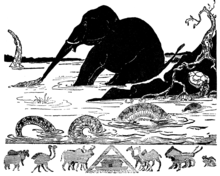
Crocodilians, especially the crocodile, have been recurring characters in stories for children. Lewis Carroll's Alice's Adventures in Wonderland (1865) contains the poem How Doth the Little Crocodile,[181] a parody of a moralising poem by Isaac Watts, Against Idleness and Mischief.[182] In J. M. Barrie's novel Peter and Wendy (1911), Captain Hook lost his hand to the crocodile.[183] In Rudyard Kipling's Just So Stories (1902), the Elephant's Child acquires his trunk by having his nose pulled very hard by the crocodile.[184] Roald Dahl's The Enormous Crocodile (1978) tells how a crocodile wanders the jungle looking for children to eat.[185]
In media
Crocodilians are often represented as dangerous obstacles[186] in action/adventure movies like Live and Let Die (1973) and Indiana Jones and the Temple of Doom (1984) or as monstrous man-eaters in horror films like Eaten Alive (1977), Alligator (1980), Lake Placid (1999), Crocodile (2000), Rogue (2007), Primeval (2007), Black Water (2007), and Crawl (2019).[187] In the film Crocodile Dundee, the title character's nickname comes from the animal that bit off his leg.[188] Some media have attempted to portray these reptiles in more positive or educational light, such as Steve Irwin's wildlife documentary series The Crocodile Hunter.[186]
See also
- Phytosaurs
References
Citations
- ^ Schmidt, K.P. 1953. A Checklist of North American Amphibians and Reptiles. Sixth edition. Amer. Soc. Ichthy. Herp. Chicago, University of Chicago Press.
- ^ a b Owen, R. 1842. Report on British Fossil Reptiles. Part II. Report British Association Adv. Sci. Plymouth Meeting. 1841:60–240.
- ^ a b Wermuth, H. 1953. Systematik der Rezenten Krokodile. Mitt. Mus. Berlin. Vol. 29(2):275–514.
- ^ Laurenti, J.N. 1768. Specimen Medicum, Exhibens Synopsin Reptilium Emendatum cum Experimentis Circa Venena et Antidota Reptilium Austriacorum. Joan. Thom. Nob. de Trattern, Vienna.
- ^ Dundee, H.A. 1989. Higher Category Name Usage for Amphibians and Reptiles. Syst. Zool. Vol. 38(4):398–406, DOI 10.2307/2992405.
- ^ S2CID 86624124.
- ^ Liddell, Henry George; Scott, Robert (1901). "An Intermediate Greek-English Lexicon". Tufts University. Retrieved 22 October 2013.
- ^ Gove, Philip B., ed. (1986). "Crocodile". Webster's Third New International Dictionary. Encyclopædia Britannica.
- ^ Kelly, 2006. p. xiii.
- ^ Polly, P. David; Guralnick, Rob P.; Collins, Alan G.; Hutchinson, John R.; Speer, Brian R. (1997). "Those diverse diapsids". University of California Museum of Paleontology. Retrieved 24 October 2013.
- ^ Hutchinson, John R.; Speer, Brian R.; Wedel, Matt (2007). "Archosauria". University of California Museum of Paleontology. Retrieved 24 October 2013.
- ^ China fossil shows bird, crocodile family trees split earlier than thought
- doi:10.1080/02724634.1997.10011027. Archived from the original(PDF) on 11 August 2017..
- ^ a b c Buffetaut, pp. 26–37.
- ^ Slow growth in crocodile ancestors pre-dated their semi-aquatic lifestyle
- PMID 24026826.
- PMID 18300130.
- S2CID 220411226.
- S2CID 83931184.
- hdl:10362/67793.
- PMID 34567843.
- PMID 35135314.
- PMID 33414557.
- PMID 12775528.
- PMID 22303441.
- PMID 12775527.
- PMID 18372192.
- ^ PMID 22431965.
- PMID 30051855.
- ^ PMID 33907305.
- ISBN 978-0-253-34087-0.
- ^ a b c d e f g h i j Grigg and Gans, pp. 326–327.
- ^ a b c d e f g h i j Kelly, pp. 70–75.
- ^ a b c Huchzermeyer, pp. 7–10.
- ^ PMID 10804158.
- ^ Grigg and Gans, p. 336.
- S2CID 33816502.
- ^ Huchzermeyer, p. 19.
- ^ ISBN 978-1-55297-613-5.
- JSTOR 1445326. Archived from the original(PDF) on 21 October 2013.
- ^ a b c Mazzotti, pp. 43–46.
- ^ Sues, p. 21.
- PMID 9716509.
- ^ Kelly, pp. 81–82.
- .
- ^ Grigg and Gans, p. 329.
- ^ Kelly, p. 69.
- ^ .
- ^ a b Grigg and Gans, pp. 227–228.
- ISBN 9781486300662.
- ^ a b Nuwer, Rachel (13 May 2013). "Solving an alligator mystery may help humans regrow lost teeth". Smithsonian.com. Archived from the original on 25 June 2013. Retrieved 4 November 2013.
- PMID 24023957.
- PMID 23671090.
- ^ Archelosaurian Color Vision, Parietal Eye Loss, and the Crocodylian Nocturnal Bottleneck
- ^ How Turtles and Crocodiles Lost the Parietal “Third” Eye and Their Differing Color Vision Adaptations
- ^ Convergent evolutionary shifts in rhodopsin retinal release explain shared opsin repertoires in monotremes and crocodilians
- S2CID 7222603.
- ^ Grigg and Gans, p. 335.
- PMID 5283940.
- S2CID 2858794.
- PMID 17683564.
- PMID 951534.
- S2CID 21995436.
- S2CID 25882439.
- ^ Ebling, F. John G. "Integument: Reptiles". Encyclopædia Britannica. Retrieved 25 October 2013.
- S2CID 6859452.
- ISBN 978-0-292-70529-6.
- ^ Salleh, Anna (25 April 2012). "Antacid armour key to tetrapod survival". ABC Science. Retrieved 20 November 2014.
- S2CID 43827650. Archived from the original(PDF) on 21 October 2013.
- ^ Kelly, p. 85.
- ^ Crocodiles Alter Skin Color in Response to Environmental Color Conditions
- ^ a b c Grigg and Gans, pp. 331–332.
- S2CID 4374046.
- PMID 9317958.
- JSTOR 3981407.
- S2CID 15080923.
- ^ Kelly, p. 78.
- S2CID 4234858.
- S2CID 206522844. Archived from the original(PDF) on 24 June 2016. Retrieved 21 October 2013.
- PMID 23638399.
- ^ PMID 18344489.
- PMID 22323207.
- .
- ^ "AquaFacts: Crocodilians". Vancouver Aquarium. Archived from the original on 16 February 2018. Retrieved 16 February 2018.
- ISBN 978-1-74110-848-4. Archived from the original(PDF) on 4 October 2009.
- ^ S2CID 225069598.
- ISBN 978-0128151600.
- ^ PMID 25657203.
- PMID 21865521.
- ^ Mazzotti, p. 54.
- ^ A Fish-Eating Enantiornithine Bird from the Early Cretaceous of China Provides Evidence of Modern Avian Digestive Features
- ^ Crocodilians Bypass Their Lungs To Improve Digestion
- ^ The Right‐to‐Left Shunt of Crocodilians Serves Digestion
- ^ Alligators and Crocodiles Have High Paracellular Absorption of Nutrients, But Differ in Digestive Morphology and Physiology
- ^ .
- ^ a b Mazzotti, pp. 48–51.
- ^ Grigg and Gans, p. 330.
- ISBN 978-0-300-07183-2.
- JSTOR 3883493.
- ^ a b c d Mazzotti, pp. 52–55.
- ^ Kelly, p. 68.
- ^ a b c d e Grigg and Gans, pp. 333–334.
- S2CID 86065169.
- ^ "Alligator Habitat | Where Do Alligators Live?". tracker.cci.fsu.edu. Archived from the original on 25 July 2017. Retrieved 25 September 2015.
- ^ a b Alcala and Dy-Liacco, pp. 136–139.
- ^ Ross, p. 68.
- ^ Alcala and Dy-Liacco, p. 141.
- ^ a b Mayell, H. (18 June 2002). "Desert-Adapted Crocs Found in Africa". National Geographic.com. Archived from the original on 14 October 2002. Retrieved 24 December 2013.
- ^ Alcala and Dy-Liacco, pp. 144–146.
- ^ Dinets, Vladimir; Britton, Adam; Shirley, Matthew (2013). "Climbing behaviour in extant crocodilians" (PDF). Herpetology Notes. 7: 3–7.
- ^ a b Alcala and Dy-Liacco, pp. 148–152.
- ^ a b c d Pooley, pp. 76–80.
- ^ Alcala and Dy-Liacco, p. 145.
- S2CID 85653669.
- JSTOR 2989771.
- ^ Alcala and Dy-Liacco, pp. 146–148.
- PMID 25829019.
- S2CID 84655220.
- ^ S2CID 84672219.
- PMID 37205749.
- .
- .
- ^ a b c Grigg and Gans, pp. 229–330.
- S2CID 8402869.
- ^ Pooley, pp. 88–91.
- ^ a b c d Kelly, pp. 86–88.
- S2CID 36102698.
- ^ Scientists Record the First 'Virgin Birth' in a Crocodile
- ^ ISBN 9780120045259.
- ^ a b c d e Lang, pp. 104–109.
- ^ Kelly, pp. 89–90.
- JSTOR 1446713.
- .
- .
- ^ a b c Pooley and Ross, pp. 94–97.
- JSTOR 1564768.
- ^ a b c Kelly, p. 91.
- S2CID 86825708.
- ^ Wylie, p. 22.
- ^ a b Huchzermeyer, p. 31.
- ^ World's largest captive croc turns 120, giving scientists 'serious knowledge on longevity'
- ^ "Crocodiles and Alligator Farms". Americana Alligator. Retrieved 7 November 2013.
- ^ Lyman, Rick (30 November 1998). "Anahuac Journal; Alligator Farmer Feeds Demand for All the Parts". The New York Times. Retrieved 13 November 2013.
- ^ Stromberg, Joseph; Zielinski, Sarah (19 October 2011). "Ten Threatened and Endangered Species Used in Traditional Medicine: Chinese Alligator". Smithsonian. Archived from the original on 30 October 2013. Retrieved 7 November 2013.
- ^ a b c d "Crocodilian Attacks". IUCN Crocodile Specialist Group. Retrieved 3 February 2013.
- ^ Pooley, Hines and Shield, pp. 174–177.
- PMID 16209470.
- ^ a b Kelly, pp. 61–62.
- ^ Kelly, pp. 108–111.
- ^ Avasthi, Amitabh (7 April 2008). "Alligator Blood May Lead to Powerful New Antibiotics". National Geographic. Archived from the original on 20 November 2014. Retrieved 20 November 2014.
- ^ Crocodile cartilage holds key to future of human joint repair, researchers say
- ISBN 978-1-84407-056-5.
- .
- ^ Whitaker, R.; Basu, D.; Huchzermeyer, F. (2008). "Update on gharial mass mortality in National Chambal Sanctuary" (PDF). Crocodile Specialist Group Newsletter. 27 (1): 4–8.
- ^ Shukla, Neha (10 June 2013). "Ghariyal population rising in Chambal". The Times of India. Archived from the original on 7 February 2014. Retrieved 7 February 2014.
- ^ Hong Xing, Jiang. "Chinese Alligator Alligator sinensis" (PDF). International Union for Conservation of Nature. Retrieved 29 November 2013.
- ^ Sautner, Stephen; Delaney, John (18 July 2009). "Critically Endangered Alligators, Born and Raised at WCS's Bronx Zoo, Now Multiplying in China's Wild". Wildlife Conservation Society. Retrieved 29 November 2013.
- ^ van Weerd, Merlijn (22 December 2009). "Local pride offers a boost to endangered crocodile". IUCN news. Archived from the original on 3 December 2013. Retrieved 29 November 2013.
- ^ "American Alligator Alligator mississippiensis" (PDF). United States Fish and Wildlife Service. 1 February 2008. Retrieved 3 September 2012.
- ^ "Rockefeller Wildlife Refuge". Louisiana Department of Wildlife and Fisheries. Retrieved 7 November 2013.
- S2CID 13857179.
- ^ Kelly, p. 41.
- ^ Kelly, pp. 49–50.
- ^ Wylie, p. 51.
- ^ "Benin: an African kingdom" (PDF). British Museum. Retrieved 29 March 2016.
- ^ Wylie, p. 28.
- ^ "Tlaltecuhtli Plaque vs. The Stone of Tizoc". Fordham University. Archived from the original on 19 October 2016. Retrieved 19 October 2016.
Many scholars refer to Tlaltecuhtli in two major depictions, one in her anthropomorphic representation as seen in the Tlaltecuhtli Plaque and the other "a spiny monster with an extended snout (cipactli), based essentially on the crocodile".
citing Nicholson, H. B.; Quiñones Keber, Eloise (1983). Art of Aztec Mexico: Treasures of Tenochtitlan. Washington: National Gallery of Art. - ^ Kelly, pp. 58–59.
- ^ Kelly, pp. 45–46.
- ^ Kelly, p. 62.
- ^ Chok, Yoon Foo; Traditional (2008). "Outwitting a Crocodile: A Traditional Malaysian Folktale". Topics Magazine. Archived from the original on 30 June 2017. Retrieved 17 October 2013.
- ISBN 9780804838733.
- ^ Wylie, pp. 120–121.
- ^ Herodotus. Histories (Book II, chapter 68 ed.).
- ^ Pliny the Elder. "8". Natural History. pp. 37–38.
- ^ Isidore of Seville. "12.6". Etymologies. pp. 19–20.
- ^ McCulloch, Florence (1960). Mediaeval Latin and French Bestiaries. Chapel Hill: University of North Carolina Press. pp. 22, 28–29.
- ISBN 978-0-521-83749-1.
- ISBN 978-2-251-32227-8.
- ^ a b Mandeville, John (1400). "31. Of the Devil's Head in the Valley Perilous. And of the Customs of Folk in diverse Isles that be about in the Lordship of Prester John". The Travels of Sir John Mandeville.
- ^ Carroll, Lewis (1865). "2". Alice's Adventures in Wonderland. Macmillan.
- ISBN 978-0-203-45133-5.
- ^ Barrie, J. M. (1911). Peter and Wendy. Hodder and Stoughton (UK); Charles Scribner's Sons (USA). pp. 87–91.
- ^ Kipling, Rudyard (1962) [1902]. Just So Stories. Macmillan. pp. 45–56.
- ^ Dahl, Roald (1978). The Enormous Crocodile. Jonathan Cape.
- ^ a b Kelly. p. 228.
- ^ Wylie p. 183.
- ^ Kelly. pp. 234–235.
Bibliography
- Grigg, Gordon; Gans, Carl (1993). "Morphology and physiology of the Crocodylia". In Glasby, Christopher J.; Ross, Graham J. B.; Beesley, Pamela L. (eds.). Fauna of Australia. Volume 2A, Amphibia and Reptilia (PDF). Australian Government Publishing Service. pp. 326–343. ISBN 978-0-644-32429-8.
- Huchzermeyer, F. W. (2003). Crocodiles: Biology, Husbandry and Diseases. CABI. ISBN 978-0-85199-656-1.
- Kelly, Lynne (2007). Crocodile: Evolution's greatest survivor. Orion. ISBN 978-1-74114-498-7.
- Ross, Charles A., ed. (1992). Crocodiles and Alligators. Blitz. ISBN 978-1-85391-092-0.
- Sues, Hans-Dieter. "The Place of Crocodilians in the Living World". pp. 14–25.
- Buffetaut, Eric. "Evolution". pp. 26–41.
- Mazzotti, Frank J. "Structure and Function". pp. 42–57.
- Ross, Charles A.; Magnusson, William Ernest. "Living Crocodilians". pp. 58–73.
- Pooley, A. C. "Food and Feeding Habits". pp. 76–91.
- Pooley, A. C.; Ross, Charles A. "Mortality and Predators". pp. 92–101.
- Lang, Jeffrey W. "Social Behaviour". pp. 102–117.
- Magnusson, William Ernest; Vliet, Kent A.; Pooley, A. C.; Whitaker, Romulus. "Reproduction". pp. 118–135.
- Alcala, Angel C.; Dy-Liacco, Maria Teresa S. "Habitats". pp. 136–153.
- Pooley, A. C.; Hines, Tommy C.; Shield, John. "Attacks on Humans. pp. 172–187.
- Wylie, Dan (2013). Crocodile. Reaktion Books. ISBN 978-1-78023-087-0.
External links
- Florida's Museum of Natural History: Crocodilians Archived 8 July 2011 at the Wayback Machine
- Crocodylians (photos with information), Flickr
- Crocodile (By wikiversity)

